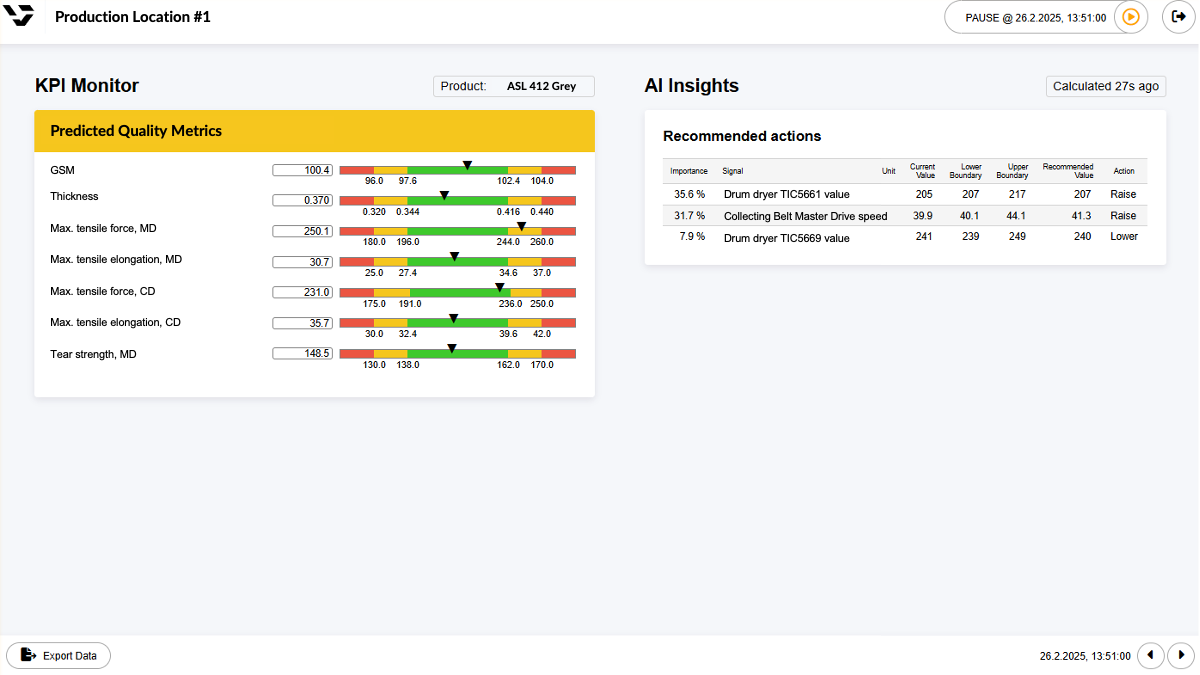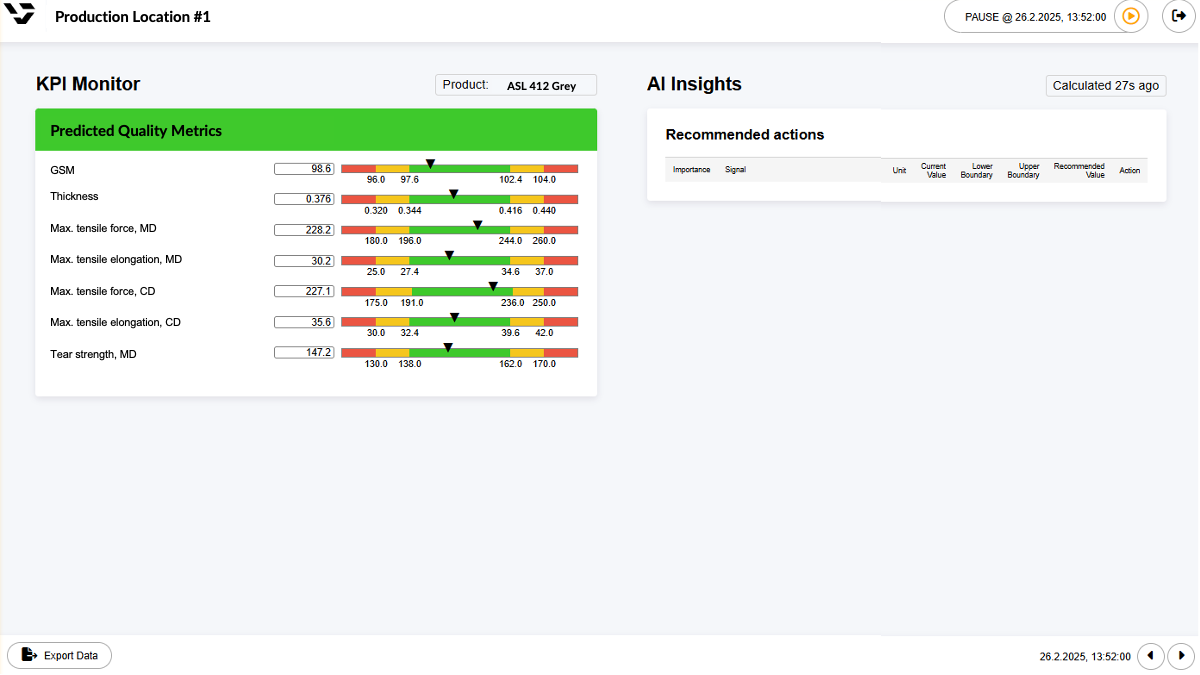

Operational Excellence frameworks, such as Lean, Six Sigma, TPM, and Kaizen have long provided manufacturers with a solid foundation for improvement. Through structured projects and disciplined methodologies, they’ve helped reduce waste, increase output, and raise quality standards.
But manufacturing environments have changed.
Production lines have grown in complexity, variability, and speed. Consider a line with 1,600 measured parameters, 60+ controllable signals, and seven critical quality KPIs—all influenced by dozens of interdependent factors. The team is expected to meet multiple, often conflicting goals: minimizing energy use, stabilizing quality, reducing CO₂ emissions, and maximizing throughput—under increasingly dynamic conditions.
This level of operational complexity is now common in process industries like papermaking, nonwovens, gelatin, steelmaking, electrode manufacturing and many more. And in these environments, timely and precise decisions are not optional—they’re essential.
While frameworks like PDCA or DMAIC remain valuable, they face structural limitations under these conditions:
These methods don’t fail because they’re wrong—they simply weren’t built for the pace, dimensionality, and real-time decision needs of modern operations.
The result? Even experienced teams are left navigating countless micro-decisions without systematic, data-driven support. That leads to excess energy use, quality drift and scrap, and untapped throughput—often reflected in OEE levels far below what the line could truly achieve.
This is where PBX (Process Booster X) delivers substantial relief. It acts as a real-time Operational Excellence CoPilot - an intelligent system that understands how your process actually behaves and continuously recommends the next-best action to operators, in real time.
Importantly, PBX is not a one-time fix—it’s continuous operational intelligence.
While traditional improvement programs are essential for building robust processes, they’re fundamentally project-based and episodic. Once the SOPs are in place, PBX picks up where they leave off—guiding operations minute by minute through variability, trade-offs, and dynamic plant conditions.
Here’s how it works:
At the start of the project, subject matter experts (SMEs) define the KPIs and specify which setpoints PBX is allowed to adjust—along with their permissible ranges.
PBX then constructs a causal model from historical process data - no manual feature engineering required - by learning from four essential data types:
Just as an engineer learns how a system behaves by tweaking inputs and observing results, PBX learns from historical interventions to model the true cause-and-effect structure of the line.
This causal model is not just a map—it acts as a simulation engine. Once deployed, PBX uses live data to simulate how changes will impact KPIs and then recommends safe, effective setpoint adjustments in real time—always within guardrails defined by the SME.
In addition, PBX supports the definition of explicit utility functions to guide its decision-making—optimizing for goals such as energy efficiency, cost reduction, CO₂ footprint, or other operational priorities specified by the team. This ensures that its real-time recommendations are not only causally sound, but also aligned with concrete business objectives.
PBX doesn’t replace your existing methods—it extends and operationalizes them in real time.
Here’s how it integrates with your workflow:
You still lead improvement projects. You still define CTQs. But instead of waiting for audits or control charts to detect drift, PBX flags issues early—and proposes targeted, data-backed actions for operators to take immediately.
If your production is dynamic, complex, and data-rich - and operators are constantly chasing a moving target - PBX acts as a real-time copilot to help stabilize and optimize performance. It brings the most value when traditional methods can no longer keep pace with variability and multidimensional trade-offs.
PBX is most effective when:
✅ You monitor hundreds or thousands of parameters
✅ You need to balance multiple, often conflicting KPIs (e.g., quality, energy, CO₂)
✅ Your team is stretched thin and can’t watch everything
✅ Process improvements tend to fade after project completion
✅ Real-time guidance could prevent costly deviations
PBX is not the right fit if:
❌ Your process is already stable and running at optimal performance
❌ You lack reliable sensor data or basic data infrastructure
❌ There are no viable interventions or control levers
❌ CTQs are not defined or business priorities are unclear
In practice, PBX looks like in this real-world example:


One minute after implementation, the drifting KPI is back under control - without disturbing the stability of the other quality indicators.
PBX doesn’t just help you run better—it helps you learn smarter.
Because PBX continuously makes causally grounded decisions, its behavior over time becomes a new lens for Continuous Improvement teams. By observing how PBX responds to different situations, you can induce hidden influences that aren't directly captured in your data.
Example: PBX frequently ramps up ventilation during summer. While ambient temperature isn’t explicitly measured, this recurring action hints at a missing driver—a thermal constraint. Instead of continuing to compensate, CI can now address the root issue (e.g., upgrade cooling or add temperature sensors).
This is where PBX goes beyond just automation:
By tracing PBX’s decisions, CI teams gain a new kind of process intelligence: A continuous stream of clues that point to what truly drives your performance—even when it’s not in your data yet.
Book a free demo / discovery call. In 60 minutes, we’ll explore your biggest challenges—and show how PBX can help you unlock hidden drivers, balance competing KPIs, and sustain CI in real time.
#OperationalExcellence #ContinuousImprovement #SixSigma #CausalAI #SmartFactory #PBX #ProcessOptimization